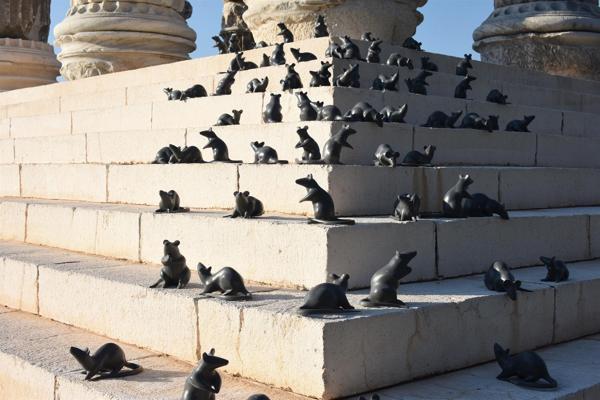Mice figurines on steps of Apollo Temple
ÇANAKKALE


Miniature figurines of mice are greeting visitors on the steps of the Apollo Smintheion Holy Field, located in Gülpınar village in the northwestern province of Çanakkale Ayvacık district. The mice are believed to have been an important part of the region’s history centuries ago.
There are 73 mice figurines on the steps of the temple, but officials are seeking to create and place 100 more of them.
Professor Coşkun Özgünel, the head of the excavations in the field, said they have been working in the field since 1980.
Özgünel said the region also made great contributions to the Trojan War, adding that friezes of the Apollo Smintheion Temple depicted the war, which Homer recounted in his epic Iliad.
He said the restoration works of the temple accelerated in 2011.
“The mice here are as important as the temple. They are related to the Apollo culture. Smintheion is known as ‘mouse’ in this region. Apollo had important missions here and his biggest mission was to punish administrators who oppressed the people and to kill mice which attacked fields and farmers. His arrow threw plague to those mice and bad administrators. In this sense, the mice of Apollo are very important for the region. In order to draw attention to this fact, we made miniature replicas of mice and placed them in the temple’s steps from ground to the top,” the professor said.
Özgünel said the mice prompted interest among guests.
“They are real-size figurines of mice. We have 73 figurines in the first stage, but 100 more will be made. Visitors of the temple are very surprised by the mice. They show great interest in the figurines. They take photos and share them on social media. This interest made us very pleased,” he said.
The professor said İÇDAŞ A.Ş. was the sponsor of six excavations in the field.
“The support of the general director of the company, Bülend Engin, has continued since 2011. As long as we have such sponsors, I believe that Turkey’s cultural and social-economic problems will be solved,” he added.
The Temple of Apollo was built in the second half of the 2nd century B.C., as a sacred place in the Troas region. Architext Hermogenes designed the temple using the pseudodipteral style. The temple contains three chambers, including a pronaos (sacred front chamber), a naos (sacred room) and an opisthodomos (back chamber), as well as the statue of Apollo made by the sculptor, Skopas.
